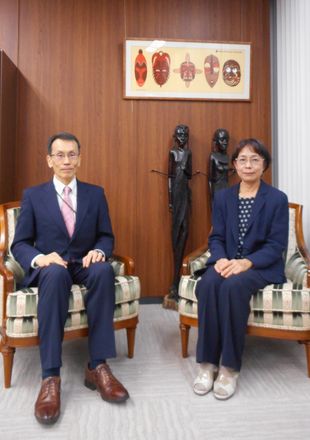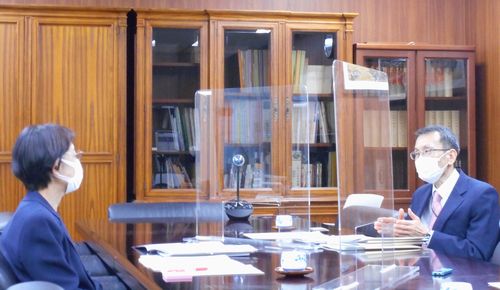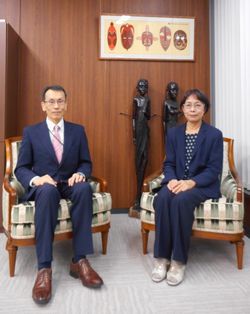A Conversation between Research Institution Leaders: the Humanities and Science and Technology Policies (Part 2)

KIBE Nobuko: President, the National Institutes for the Humanities
SAEKI Koji: Former Director General, the National Institute of Science and Technology Policy; Ministry of Education, Culture, Sports, Science and Technology
In April 2021 the Basic Act on Science, Technology, and Innovation (revised from the Basic Act on Science and Technology) came into force, adding the promotion of the humanities and the social sciences to the scope of the law. From here on, a key task for the humanities and the social sciences is to accumulate and integrate “knowledge” with that of the natural sciences, promoting and utilizing “the convergence of knowledge” in ways conducive to comprehensively understanding and solving the challenges of humanity and society.
To explore how to drive interdisciplinary integration and research for the “convergence of knowledge,” Dr. KIBE Nobuko, President of the National Institutes for the Humanities (NIHU), invited Mr. SAEKI Koji in November 2022 to engage in a dialogue. Mr. SAEKI, who was then Director General of the National Institute of Science and Technology Policy (NISTEP), the Ministry of Education, Culture, Sports, Science and Technology (MEXT), has ties with various organizations and scholars in the natural sciences. The second part of the conversation highlights examples of cross-disciplinary integration efforts on which each research organization has been working.
Creating Databases
KIBE: Currently the National Institutes for the Humanities (NIHU) is supporting the creation of databases of documents and other scholarly resources. For example, the National Institute of Japanese Literature (NIJL) has created a database of classical works in PDF format. It is also working with a professor of information science on research to make it possible to read old cursive kuzushiji characters. Computers can now decipher the kuzushiji characters quite well.
SAEKI: Apparently computers can be taught to read them.
KIBE: I remember struggling to learn to read kuzushiji when I was an undergraduate student of Japanese literature. It’s kind of perplexing that a computer can master all that so quickly, but we have to celebrate the technology if it will allow more people to enjoy classical literature. The collaboration between scholars of Japanese literature who have the knowledge required to read the originals of the classics and experts in information science who can program computers to automatically read cursive scripts makes for really good joint research.
What’s exciting about this kind of collaborative research is what it makes possible. For example, the National Institute of Japanese Literature and the National Institute of Polar Research have worked together to find records of sightings of aurora borealis in the classics and ancient chronicles. The Earthquake Research Institute at the University of Tokyo has created a database of records of earthquakes and eruptions found in documents from ancient and medieval times and analyzed them. Such data from the past will become accessible to researchers in natural disaster prevention and other fields. We would never dream that auroras were seen in Japan, but we can find a surprising number of descriptions of the aurora in Japanese classics. The documents that NIJL is currently digitalizing are mainly those of the country’s cultural and political center, but the digitalization of materials preserved in different parts of Japan is sure to enable progress in other fields of research.
In the past, as now, there were many assiduous note-takers. Just as we keep diaries, there were many people around the world who kept meticulous records of what they did each day, noting whether the weather was fine, cloudy in the afternoon, and so on. If AI can automatically read such documents, it will be possible to create databases of many such resources. Then we will be able to know what weather conditions were like around the country, ways of life, and many other things about the past.
Studying Cultural Properties Using Negative Muon Technology
KIBE: I also want to mention the muography research being conducted jointly about historical artifacts by the National Museum of Natural History and the High Energy Accelerator Research Organization. Archaeological and other artifacts, if they are made of iron, are often heavily rusted or corroded when they are unearthed, but since they are cultural properties, pieces cannot be broken off to examine their components.
SAEKI: We have heard how that technology was used to study the internal structure of the Pyramids in Egypt.
KIBE: Right. In the same way, research uses radiation with these particles to determine the nature of the metals used and other properties without defacing valuable excavated artifacts. These days, even in the fields of archaeology and history, great strides are being made in the study of objects by linking up with scientific technology. What kinds of metals were used in what place and in what way in the past? What was their composition? What materials were things made of? Now we can provide the answers to these questions without harming originals. This makes research quite different from the past.
SAEKI: Indeed, the scope of what could be seen using X-rays was somewhat limited, but the penetration of muon radiography is deeper, opening up the possibilities for non-destructive analysis.

Scene from the conversation
AI Utilization in Policy Research
SAEKI: At the National Institute of Science and Technology Policy (NISTEP), we are engaged in one project to learn how data science and AI-related technologies, including natural language processing, can be used to develop policy research. Another project is about how uses of AI relate to society from ethical, legal, and social issues (ELSI) points of view. We are pursuing these projects under the collaboration with the Center for Advanced Intelligence Project (AIP) at RIKEN.
As for specific themes, with regard to the first project mentioned, research using the methods of statistical causal inference, and citation analysis research, such as to determine whether citation relationships in English journal articles are positive or negative citations, are being conducted. With regard to the other project mentioned, as AI advances and the use of open data expands, discussions are underway to share “signs” that could change the state of science and society, and to raise issues from a medium- to long-term perspective. RIKEN, for its part, is also keenly interested in what issues will arise as AI technology develops and its use expands, and is cooperating in organizing a seminar.
KIBE: Until now, research in the humanities has not been compiled into databases very often, but I think that as databases become more widespread, the tasks of verifying the quality of research and ascertaining how it relates to research in other fields and to society will have to be addressed.
Digital Humanities (DH)
KIBE: The amount of data in the humanities still not available in digital form is tremendous. This is true of scholarly papers and studies, and one reason is that there are many that are not written in English.
SAEKI: And there is a great deal not written in English in area studies.
KIBE: Yes, and area studies are naturally supposed to be published in the local language. Lately, translation systems that can deal with various languages have become quite advanced. I think it is important to start digitization anyway, because I believe such technology will soon be available to search and retrieve not only in English but also in various other languages.
Also, NIHU’s constituent research institutes have many documents as well as scholarly articles. There are old documents in the institutes’ collections, and museums have artifacts. The Research Institute for Humanity and Nature has materials related to nature and disasters. The fourth mid-term goals and plans of NIHU are to digitize not only text data but also various other types of data, and to develop research based on these digitalized resources.
To this end, with the database of Pre-modern Japanese Texts at the National Institute for Japanese Literature leading the way, we are trying to digitize the vast amount of data at NIHU’s other institutes. Once digitized, the data can be analyzed and classified by computer using AI. It will also make it possible to bring together related data and to analyze and collect data across disciplines. I believe access to such resources will give us new perspectives for advancing humanities research.
SAEKI: The problem of old journals being thrown away has been solved by digitizing them so that many can be viewed and their contents searched back to the first issue. If we can view documents on screen without having to search in old catalogs and bring physical volumes out of storage, previous publications can be utilized much more efficiently.
KIBE: Not limiting ourselves to NIHU, we would like to promote digitization in cooperation with universities as well, since they also have a lot of data. The more data we have, the more possibilities there will be. We hope to pursue this project experimentally first at NIHU, and then see it expand to universities and other research institutions.
SAEKI: At present, this digitalization process is an immense task that cannot be automated—it must be carried out by human hands.
KIBE: Yes.
SAEKI: The books and documents are all of the various sizes, so using automation has its limits. This may provide the opportunity for increased employment, though.
KIBE: Yes, indeed. And there is a tremendous amount of material in not only the humanities but the sciences as well that is yet to be digitized.
SAEKI: Without progress in digitization, documents that could otherwise generate value will be of little use. The same is true in the natural sciences. Even if valuable data is collected, without being properly managed it will not be valuable. The advancement of research depends upon the proper maintenance of data and broad utilization that transcends organizations and disciplines. In particular, when AI is recently reading journals and other documents, everything needs to be premised upon digitization.
KIBE: Yes, that’s why we want to digitize as much as possible. Fortunately, advances have also been made in storage media gradually to store even massive amounts of data.
SAEKI: Yes, it will be really good if digitization progresses.
KIBE: I agree, and we must consider not just how to store information but how it can be accessed. How to get hold of what we want from all that is accumulated, to put it simply, how to “tag” things properly. What kind of tagging will we do? I hope that researchers in the sciences and the humanities will jointly study this task.
SAEKI: It’s rather unsung work, but very important for infrastructure building. As a matter of fact, at NISTEP we have been paying great attention to the transformation of science and society (open science) as such research data infrastructure becomes available, and we consider that issue an important part of our work. I understand that you, Dr. KIBE, are also participating on the Science Council of Japan’s committee on open science.
KIBE: Yes, I belong to the Research Committee on Data Infrastructure and its Utilization to Promote Open Science, and we are exploring how data-driven science can open up new frontiers in scholarship and society. I do what I can to get the committee to appreciate the characteristics of research in the humanities.
SAEKI: Since NISTEP is focusing on the future of not only science and technology but also the humanities and the social sciences, we may consider collaboration to clarify how open science will shape science and society.
KIBE: That’s a very good idea. I believe that open science will allow researchers in different fields to meet and create new research. I would very much like to collaborate and work together to converge knowledge.
Moderator: OHBA Go, Research Fellow, the Center for Innovative Research, the National Institutes for the Humanities
KIBE Nobuko
President, NIHU
Ph.D., Kyushu University, the Faculty of Letters. After serving as Professor at Kagoshima University and at the National Institute for Japanese Language and Linguistics (NINJAL), she assumed her present position in 2022. Her research interests are linguistics, Japanese dialectology, phonology, and phonetics.
SAEKI Koji
Former Director General (until the end of March 2023), National Institute of Science and Technology Policy (NISTEP). After joining the former Science and Technology Agency (today’s MEXT), SAEKI served as Deputy Director General of the National Space Policy Secretariat, the Cabinet Office; Director General of the Research and Development Bureau, MEXT; and Vice President of the Japan Science and Technology Agency.

